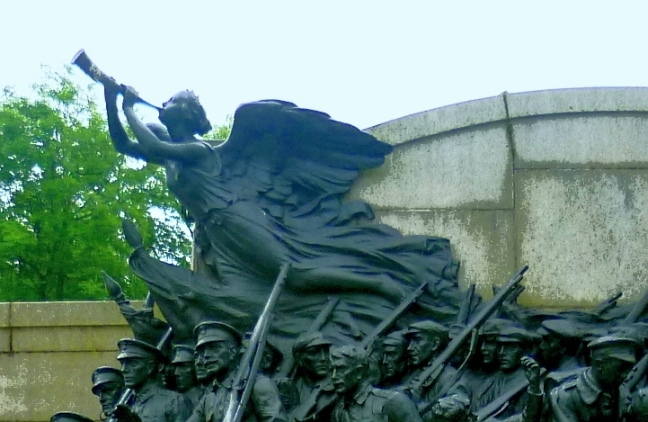
The Response by Sir William Goscombe John. Unveiled by the Prince of Wales in 1923; restored and rededicated, 2007. Bronze figures in high relief on a rusticated granite screen, with low reliefs on the reverse, by Barras Bridge, in the grounds of St Thomas's Church, Newcastle-upon-Tyne. Photographs by the author (2011). [Click on thumbnails for larger images.]


Left to right: (a) As Renown blows her horn (see below), the drummer boys at the fore are poised and alert (compare them to John's famous drummer boy on his King's Liverpool Regiment Memorial), while the officers ranged behind them look staunchly forward, rifles at the ready. (b) Pressing on after them, among those already in uniform, are some still in cloth caps and work-clothes; several are seen making their last farewells. One of the men in work-clothes carries a large spanner. Another, the last on the right, is kissing a baby held up to him” by his wife, who has a second child clinging to her skirts. Of the two little boys further along, one seems to be carrying his father's kit, while the other is beckoning the men on.



Left to right: (a) Renown blows her horn, her robes flowing as she moves with the current of the wind. (b) The drummer boys. (c) The memorial is sited on highly visible ground to the side of St Thomas the Martyr (1830), the landmark city church designed by the architect John Dobson. It is close to the town centre and the universities.
The memorial in its prominent position is another deeply touching public monument by this exceptional Welsh sculptor of the late nineteenth-/early twentieth-century period.

On the reverse are low reliefs confirming the Northumbrian battalions' vital role in Newcastle's civic history.
According to a nearby plaque, the monument was commissioned by Sir George and Lady Renwick to commemorate the raising of several companies of Northumberland Fusiliers, and also to celebrate Sir George's half-century of contribution to the commercial wealth of Newcastle, and the safe return of the Renwicks' five sons from the Great War. Thought to focus on the 5th Northumberland Fusiliers, the memorial shows a company of soldiers headed by the figure of Renown, impelled not by thoughts of personal glory but” by hopes of victory for their country: the Latin motto, "Non sibi sed patriae," means "Not for self but for country." The composition was probably inspired by the day in 1915 when the 5th set off from their camp in Gosforth to Newcastle Central Railway Station, led by their drummer boys, en route to the battlefields of Belgium and France. The city roads had been lined with crowds of well-wishers: indeed, as the men press forward here, some pause to take leave of their families. As well as the high relief of the soldiers, there are low reliefs on the reverse side, St George standing on two seahorses with linked tails (a feature taken from the city's coat-of-arms), a seventeenth-century militia man with the date 1674 below him, and a Northumberland fusilier with the date 1919 below him.
Alan Berg, former Director General of the Imperial War Museum, has described the bronze relief on the front as "one of the finest sculptural ensembles on any British monument," saying that it displays "John's virtuosity to the full" and should be recognised as "a key work in this genre" (qtd. in Usherwood et al. 91). Unsurprisingly, masses of people turned out for the inauguration of the memorial in 1923.
Photographs by the author (2011). [You may use these images without prior permission for any scholarly or educational purpose as long as you (1) credit the photographer and (2) link your document to this URL in a web document or cite the Victorian Web in a print one.]
Bibliography
Usherwood, Paul, Jeremy Beach and Catherine Morris. Public Sculpture of North-East England. Liverpool: Liverpool University Press, 2000.
Last modified 23 June 2011